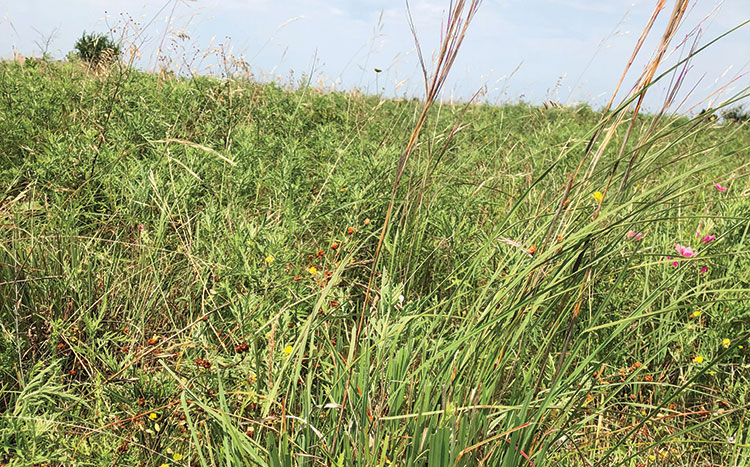
Are you one of the lucky producers who still has native tall grass prairie? If you have this resource, what is the best way to utilize it in order to meet your operational goals of livestock forage, hay production, or wildlife habitat? Furthermore, what is the best way to maintain indefinitely the productivity and sustainability of this resource while meeting your goals?
If you have cattle and are able to graze the prairie, set a conservative stocking rate in order to ensure long-term sustainability. This also helps to avoid additional expenses such as weed and brush spraying and feeding hay or cubes over an extended period of time each year. Your local Natural Resources Conservation Service (NRCS) office, county extension office, or a livestock consultant can assist you with setting a stocking rate. Once your stocking rate is correct, rotational graze early in the growing season and then rest the prairie later in the growing season.
Return in the fall to graze the dormant grass as standing hay. This capitalizes on the fact that in the Great Plains about 50% of plant growth for the year is accumulated by June 15 and 75% of plant growth is accumulated by July 15. By grazing early in the growing season and then resting the pasture, plants can recover from grazing before going into the dormant season. Rest and recovery after a grazing event are essential for maintaining a native plant community.
A haying option
Consider haying the prairie as an income source if you do not have cattle, are not able to contract graze the prairie, and are not interested in maintaining wildlife. Don’t cut a native prairie for hay more than once a year. This needs to be done by the first week of July. Hay quality will be better, and it will allow plants to recover before going into the dormant season. If you wait until later in the year to cut, there will be more quantity, but the quality will be much lower, and plants will not have adequate time to recover.
Leave a 6-inch stubble height when cutting for hay. If cutting hay is the option you choose, take soil samples once every three years. Fertilizing native plant communities is usually not economically advantageous, but when removing hay from the field year after year, nutrients become depleted. The plant community will decline in quality and composition as a result.
Enhance wildlife
Native tall grasses and a diverse plant community prairie are ideal habitat for wildlife. Wildlife habitat management goals will be much easier to accomplish on native prairie compared to introduced forages. There are management options to consider in order to manage wildlife habitat, and they involve disturbance and rest.
Applying grazing and fire with appropriate rest intervals is the best way to manage native prairie for wildlife habitat. For example, divide the native prairie into different units and rest one unit for the entire growing season while grazing or burning the other units. When possible, apply rotational grazing to boost stock density while leaving a 6- to 8-inch stubble height. If you can’t rotationally graze, intensive early stocking and removing cattle by July 1 is also a good option.
Fire can be applied periodically to the unit that is not hayed or rested in order to bolster plant diversity and structure. Depending on the plant species composition in the prairie, fire can be applied during the dormant or growing season if changes in composition are needed for the management of any particular wildlife species or group of wildlife species. The frequency at which fire should be applied depends on weather and the amount of deviation you desire from the current plant community.
If you want to manage for wildlife and hay, only hay two-thirds of the prairie each year as the tall grasses are excellent habitat for ground nesting birds. Each year, leave a different third of the pasture out of hay production. Do not spray for weeds in the hayed areas. The native forbs or “weeds” in the prairie are important seed producers that provide food for birds and small mammals, and the flowers are excellent for pollinators.
Control brush
You will also want to monitor the prairie for woody plant encroachment. If woody plants become a problem, use approved and effective herbicides for target species and an individual plant treatment method to control their occurrence. Another option is to use prescribed burning to control woody plant encroachment. Some species of woody plants will be killed with prescribed burning and others will be top killed but resprout after the prescribed fire. So, a prescribed fire once every three to five years may be needed to maintain control of woody plant encroachment.
This article appeared in the March 2020 issue of Hay & Forage Grower on page 29.
Not a subscriber? Click to get the print magazine.

